The subcompact SUV segment is one of the hottest battlegrounds in the automotive world, offering a compelling blend of maneuverability, fuel efficiency, and surprising versatility. For 2025 and 2026, two strong contenders stand out: the refined 2026 Honda HR-V and the stylish 2025 Mazda CX-30. While the 2026 HR-V is still a future model, we can anticipate its evolution based on Honda’s trajectory, likely building on its strengths while refining its offerings. The 2025 Mazda CX-30, meanwhile, continues to impress with its premium feel and engaging drive.
Choosing between these two can be challenging. Both offer compelling reasons to buy, but they cater to slightly different priorities. Are you seeking ultimate practicality and space, or a more upscale feel and driving engagement? In this detailed comparison, we’ll break down every key aspect, helping you decide which of these popular subcompact SUVs is the perfect fit for your lifestyle.
Let’s dive in!
1. Exterior Design: Practicality Meets Premium Aesthetics
The visual appeal of an SUV is often the first thing that catches the eye. The Honda HR-V and Mazda CX-30 approach exterior design with distinct philosophies.
- 2026 Honda HR-V (Anticipated): Honda typically favors a design language that balances modern aesthetics with maximum interior utility.
- Evolutionary Styling: We expect the 2026 HR-V to continue with a sleek, contemporary design, likely refining the current generation’s clean lines and somewhat understated elegance. It will likely feature a more mature and less polarizing look than its earliest iterations.
- Emphasis on Space: Its design prioritizes a tall roofline and practical proportions, hinting at its renowned interior spaciousness. Expect functional lighting elements and a cohesive, approachable appearance.
- Brand Identity: Honda’s design often leans towards broad appeal and timelessness, avoiding overly aggressive or niche styling.
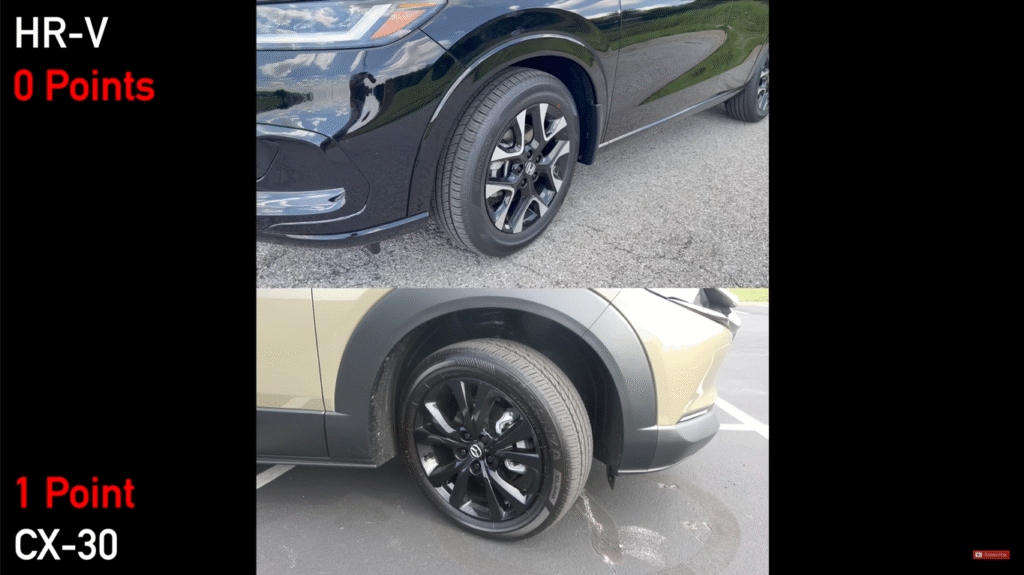
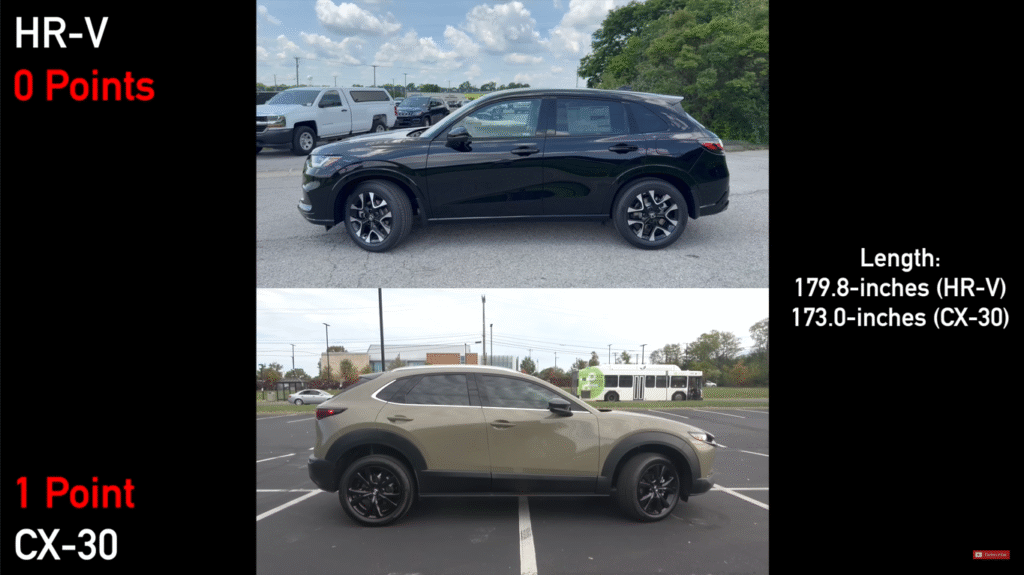
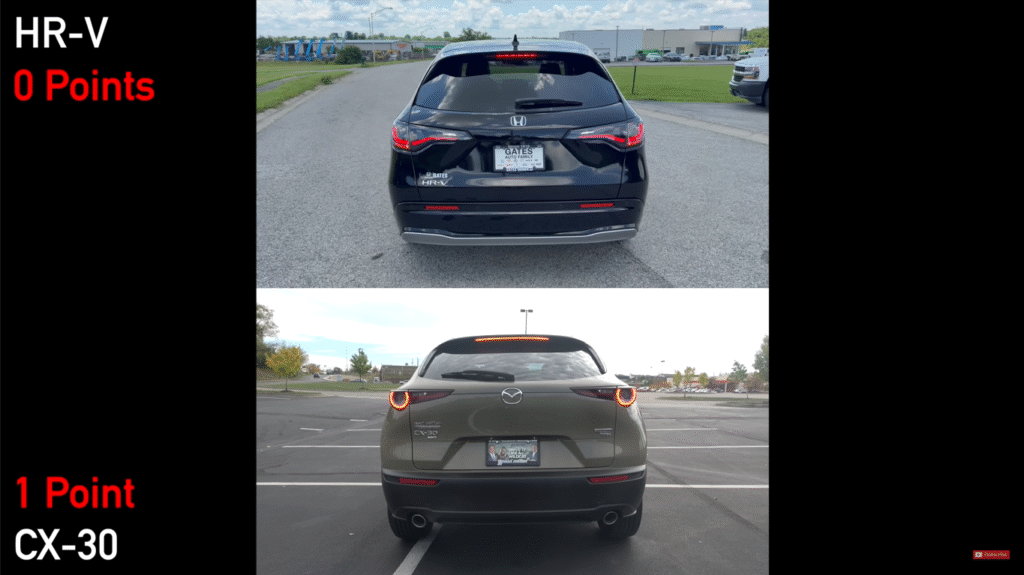
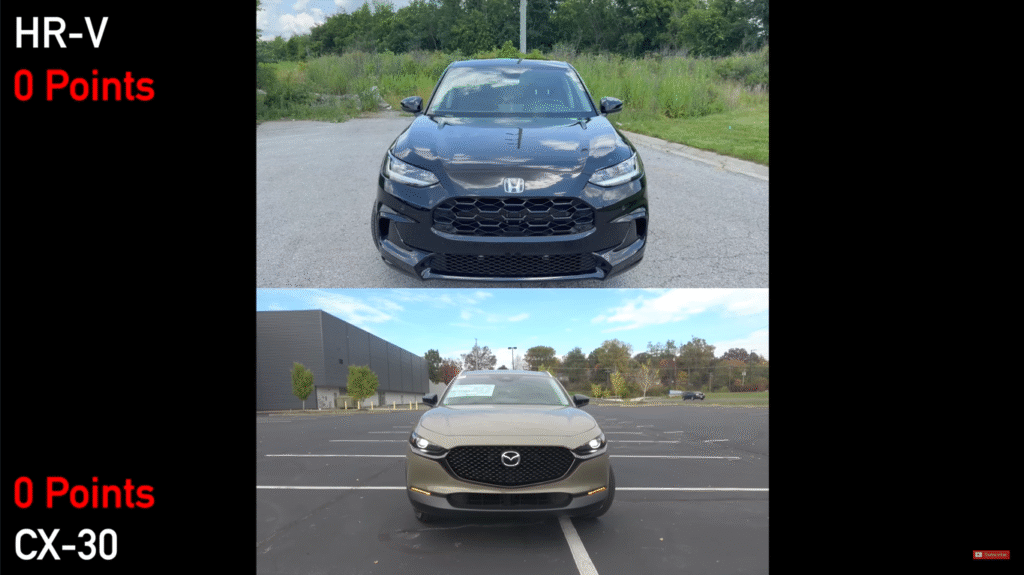
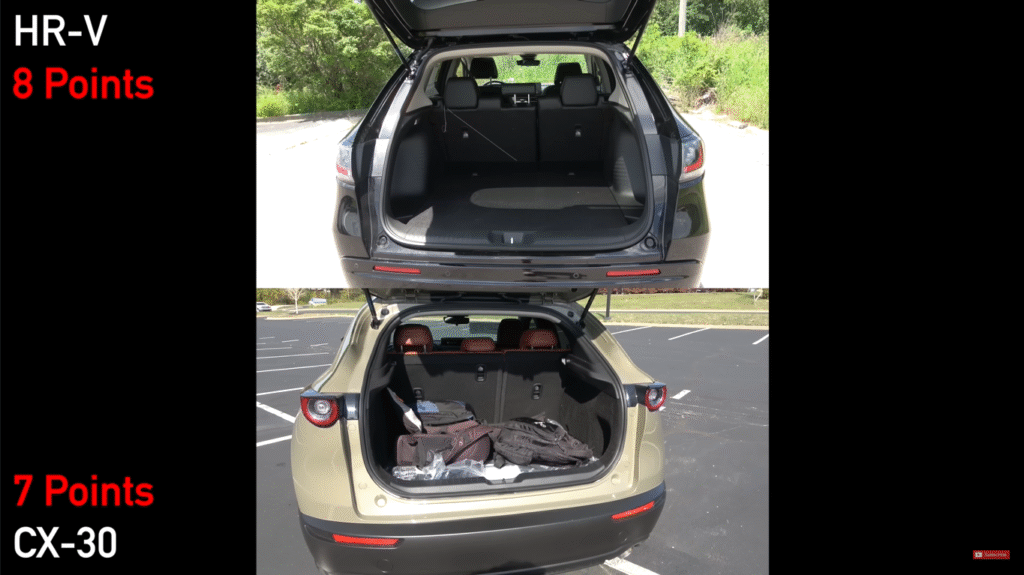
- 2025 Mazda CX-30: Mazda, conversely, emphasizes a more sculpted, premium, and dynamic aesthetic, often punching above its class.
- Kodo Design Language: The CX-30 embodies Mazda’s “Kodo” (Soul of Motion) design, characterized by flowing lines, minimal creases, and a sense of movement. Its proportions are more car-like and athletic.
- Upscale Presence: With its long hood, sweeping roofline, and prominent grille, the CX-30 looks more expensive than it is. The black body cladding, while sometimes debated, adds to its rugged yet refined crossover appeal.
- Lighting Signature: Signature LED lighting elements, both front and rear, contribute to its sophisticated and recognizable road presence.
Verdict: If you prefer a more understated, practical, and broadly appealing design, the HR-V might be your choice. If you value a truly premium, sculpted, and sporty aesthetic that stands out, the CX-30 holds the edge.
2. Interior Design & Quality: Versatility vs. Refinement
The cabin experience is where these two SUVs truly differentiate themselves, reflecting their core brand values.
- 2026 Honda HR-V (Anticipated): Honda interiors are typically known for their clever packaging, excellent ergonomics, and durable materials, prioritizing user-friendliness.
- Spacious and Airy: Expect a cabin that feels remarkably spacious for its class, with good headroom and legroom for all occupants. The design will likely be clean and uncluttered, promoting an airy feel.
- Clever Storage: Honda excels at practical storage solutions. Anticipate numerous cubbies, large door pockets, and a well-thought-out center console.
- Material Quality: Materials will likely be durable and functional, with a focus on soft-touch surfaces where it matters most, offering a good balance of quality for its price point.
- Ergonomics: Controls will be intuitively placed and easy to use, a hallmark of Honda’s user-centric design.
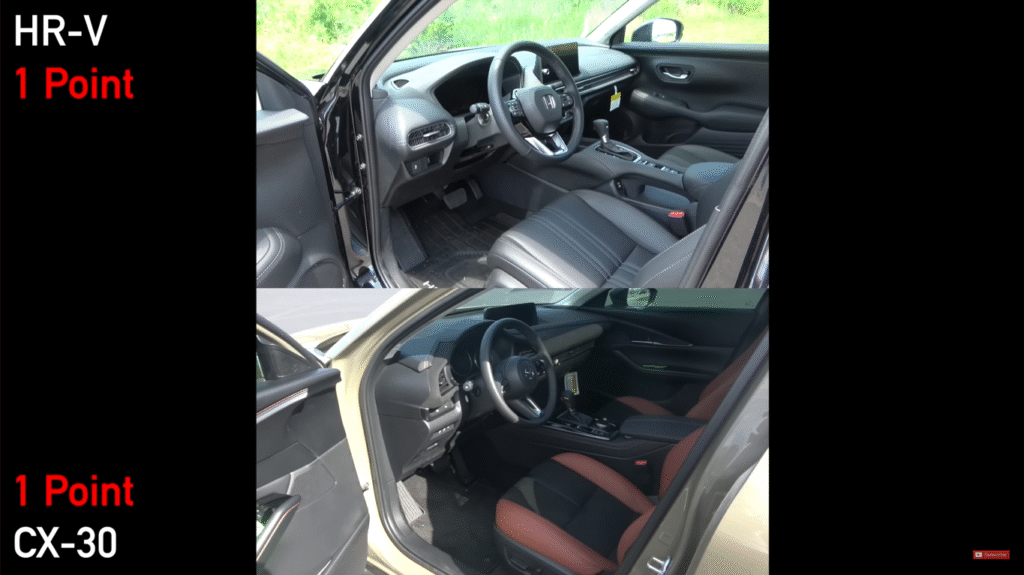
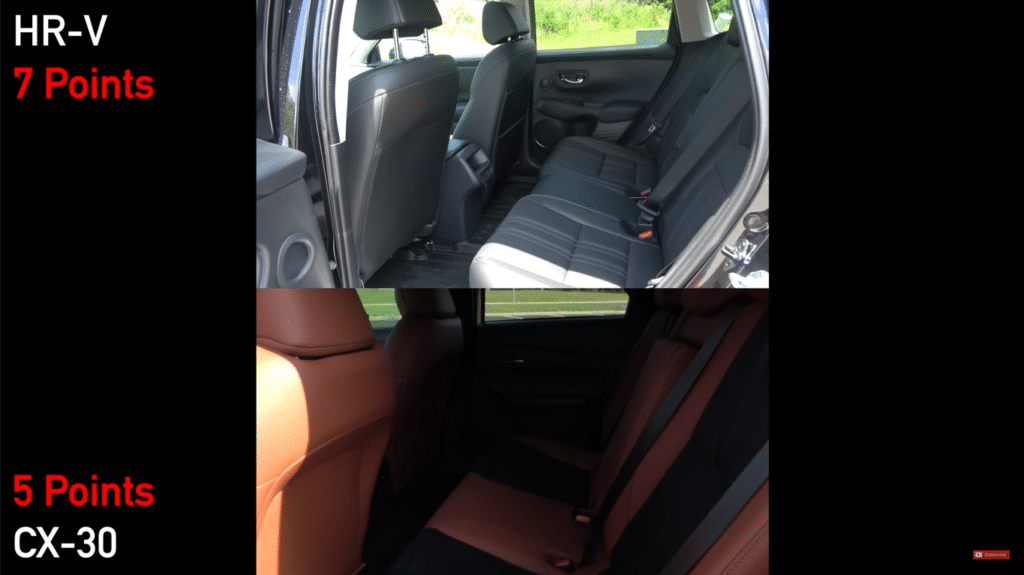
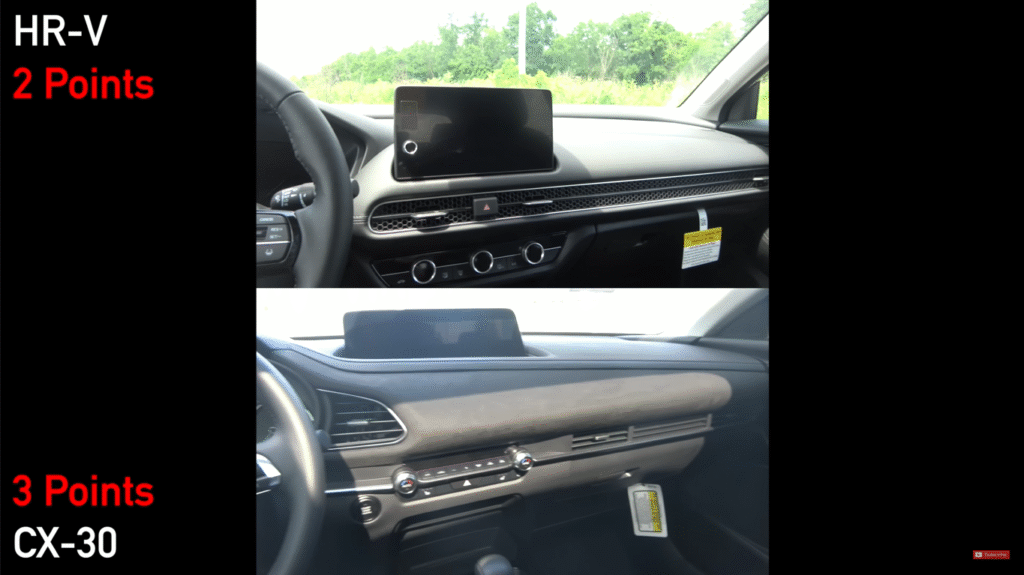
- 2025 Mazda CX-30: Mazda interiors are consistently praised for their upscale materials, refined layout, and driver-focused cockpit.
- Premium Ambiance: The CX-30’s cabin feels genuinely premium, often mistaken for a luxury vehicle. High-quality soft-touch materials, well-damped controls, and tasteful metallic accents are abundant.
- Driver-Centric Layout: The dashboard is elegantly minimalist and oriented towards the driver, creating an intimate and engaging cockpit feel.
- Refined Touches: Details like the stitched dashboard, available genuine leather, and precise switchgear contribute to a sophisticated atmosphere.
- Comfort: Seats are generally supportive and comfortable, designed for longer journeys.
Verdict: For maximum interior space, clever versatility, and straightforward ergonomics, the HR-V is likely to be superior. For a truly premium feel, upscale materials, and a driver-focused, elegant cabin, the CX-30 clearly leads.
3. Performance & Powertrain: Efficiency vs. Engagement
The driving dynamics and engine options are another key area of divergence between these two subcompact SUVs.
- 2026 Honda HR-V (Anticipated): Honda typically offers efficient and refined powertrains, prioritizing smooth operation and good fuel economy.
- Engine Options: The current HR-V uses a 2.0-liter four-cylinder engine. The 2026 model might see a slight power bump or potentially introduce a hybrid option, aligning with Honda’s broader electrification strategy. Expect smooth, adequate power for city driving and highway cruising.
- Transmission: A continuously variable transmission (CVT) is standard, known for its smooth power delivery and fuel efficiency.
- Drivetrain: Front-wheel drive (FWD) will be standard, with available all-wheel drive (AWD) for added traction.
- 2025 Mazda CX-30: Mazda prioritizes driving engagement, offering engines that feel more responsive and powerful, especially with its optional turbo.
- Standard Engine: The base engine is a 2.5-liter four-cylinder, delivering a respectable amount of power for the segment.
- Optional Turbo Engine: A significant advantage for the CX-30 is its available 2.5-liter turbocharged four-cylinder engine. This potent engine delivers significantly more horsepower and torque, transforming the CX-30 into a genuinely quick and engaging vehicle.
- Transmission: A conventional 6-speed automatic transmission is standard across the lineup. This provides a more traditional and often more engaging feel than a CVT.
- Drivetrain: All-wheel drive (AWD) is standard on all CX-30 trims, a key differentiator.
Verdict: If fuel efficiency and smooth, unobtrusive power delivery are your top priorities, the HR-V will likely suffice. However, if you crave more spirited acceleration, a more traditional automatic transmission feel, and the option of a powerful turbo engine, the CX-30 is the clear winner.
4. Ride & Handling: Balanced Comfort vs. Sporty Agility
The feel of the road and how the vehicle handles corners are crucial aspects of the driving experience.
- 2026 Honda HR-V (Anticipated): Honda vehicles are generally tuned for a comfortable and composed ride, suitable for daily commuting and varied road conditions.
- Comfort-Oriented Ride: Expect the HR-V to offer a plush and absorbent ride, effectively soaking up bumps and road imperfections. This makes it a comfortable companion for city driving and longer highway stretches.
- Predictable Handling: Handling will be predictable and stable, with light steering that’s easy to maneuver in tight spaces. It will likely prioritize ease of driving over sporty dynamics.
- 2025 Mazda CX-30: Mazda is renowned for its “Jinba Ittai” philosophy (rider and horse as one), translating to vehicles with engaging and connected driving dynamics.
- Sporty and Agile: The CX-30 offers a more athletic and engaging driving experience. Its steering is precise and well-weighted, providing good feedback from the road.
- Composed Cornering: The suspension is tuned for a balance of comfort and control, allowing for composed cornering with minimal body roll. It feels more “driver’s car” than a typical subcompact SUV.
- Refined Ride: Despite its sporty nature, the ride quality remains refined and comfortable, avoiding harshness.
Verdict: For a more relaxed, comfort-focused ride that handles everyday bumps with ease, the HR-V is likely to be preferred. For drivers who enjoy a more connected, agile, and sporty feel behind the wheel, the CX-30 offers a more engaging experience.
5. Technology & Features: User-Friendly vs. Premium Infotainment
Both SUVs come equipped with modern technology, but their infotainment systems and feature sets have distinct characteristics.
- 2026 Honda HR-V (Anticipated): Honda typically offers intuitive and user-friendly infotainment systems, often with physical controls for key functions.
- Infotainment System: Expect a responsive touchscreen infotainment system, likely with wireless Apple CarPlay and Android Auto as standard or widely available. Physical knobs for volume and tuning are a common and appreciated Honda feature.
- Digital Displays: A digital instrument cluster will likely be available, offering customizable information.
- Convenience Features: Standard features will likely include automatic climate control, push-button start, and multiple USB ports. Higher trims will add features like heated seats, a power moonroof, and potentially a wireless charging pad.
- 2025 Mazda CX-30: Mazda’s infotainment system is known for its unique control method and premium presentation.
- Mazda Connect Infotainment: The CX-30 features the Mazda Connect infotainment system, primarily controlled by a rotary knob on the center console. While it also has a screen, it’s designed for minimal touch interaction while driving. Wireless Apple CarPlay and Android Auto are standard.
- Premium Audio: Higher trims offer a premium Bose sound system.
- Advanced Features: Available features include heated front seats, a heated steering wheel, a power liftgate, and a head-up display, contributing to its upscale feel.
- Digital Cluster: A partially digital instrument cluster provides key driving information.
Verdict: If you prefer a more traditional touchscreen interface with direct touch and physical controls, the HR-V might be more appealing. If you appreciate a rotary controller for infotainment (designed for safer operation while driving) and a more premium audio experience, the CX-30 stands out.
6. Safety Features: Comprehensive Suites for Peace of Mind
Both Honda and Mazda prioritize safety, equipping their vehicles with comprehensive suites of driver-assistance technologies.
- 2026 Honda HR-V (Anticipated): Honda’s safety suite, Honda Sensing, is typically standard across most trims.
- Honda Sensing: This suite includes features like Adaptive Cruise Control, Lane Keeping Assist System, Road Departure Mitigation System, and Collision Mitigation Braking System.
- Visibility: Honda vehicles generally offer good outward visibility, aiding in overall safety.
- Airbags: Expect a full complement of airbags.
- 2025 Mazda CX-30: Mazda’s i-Activsense safety suite is also comprehensive and often standard.
- i-Activsense: This suite includes Mazda Radar Cruise Control with Stop & Go, Lane-keep Assist, Lane Departure Warning, Driver Attention Alert, and Smart Brake Support.
- Standard AWD: The standard AWD across all trims can be considered a safety advantage, providing better traction in various conditions.
- Visibility: While the CX-30’s sleek design might slightly compromise rear visibility compared to the HR-V, its available 360-degree camera system helps mitigate this.
Verdict: Both vehicles offer robust safety features, providing excellent peace of mind. The choice here might come down to personal preference for specific system implementations.
7. Cargo & Practicality: The Magic Seat Advantage vs. Refined Space
Practicality and cargo versatility are often key decision-makers in the SUV segment.
- 2026 Honda HR-V (Anticipated): The HR-V is legendary for its interior flexibility, primarily due to Honda’s innovative Magic Seat system.
- Magic Seat: This unique rear seat system allows the seat bottoms to flip up, creating a tall, open cargo area for vertical items. The seats also fold flat to create a long, flat load floor.
- Cargo Volume: Expect class-leading cargo volume for its size, both with the rear seats up and folded down.
- Low Load Floor: A relatively low load floor makes it easier to load heavy or bulky items.

- 2025 Mazda CX-30: While not as overtly versatile as the HR-V, the CX-30 offers a well-designed and usable cargo area.
- Usable Space: The cargo area is well-finished and practical for everyday needs, though not as expansive as the HR-V.
- Rear Seats: The rear seats fold down to expand cargo capacity, but they don’t offer the same flexibility as Honda’s Magic Seat.
- Power Liftgate: Higher trims offer a power liftgate for added convenience.
Verdict: For ultimate cargo flexibility, class-leading space, and the unique Magic Seat versatility, the HR-V is the undisputed winner. The CX-30 offers good, well-finished cargo space for its size but can’t match the HR-V’s ingenuity.
8. Pricing: Value for Money
Pricing is always a critical factor. We’ll make some assumptions for the 2026 HR-V based on current trends.
- 2026 Honda HR-V (Anticipated): Expect the 2026 HR-V to be competitively priced within the subcompact SUV segment.
- Starting Price: Likely to start in the low to mid-$20,000 range for base FWD models.
- Top Trims: Fully loaded AWD models could reach into the low $30,000s.
- Value Proposition: Honda typically offers strong resale value and reliability, contributing to long-term value.
- 2025 Mazda CX-30: The CX-30 is already known for offering a premium experience at a competitive price.
- Starting Price: Currently starts in the mid-$20,000 range.
- Top Trims: Turbo models with all options can push into the mid to high $30,000s.
- Standard AWD: All CX-30 models come standard with AWD, which adds to its baseline value compared to FWD-only competitors.
Verdict: Both offer good value, but their value propositions differ. The HR-V will likely appeal to those seeking maximum space and Honda reliability at a slightly lower entry point. The CX-30 offers a more premium feel and standard AWD for a slightly higher starting price.
Conclusion: Which Subcompact SUV is Right for You?
Both the 2026 Honda HR-V and the 2025 Mazda CX-30 are excellent choices in the subcompact SUV segment, but they appeal to different types of buyers.
- Choose the 2026 Honda HR-V if you prioritize:
- Maximum Interior Space & Versatility: Especially with the unique Magic Seat system.
- Fuel Efficiency: A strong focus on economical powertrains.
- Reliability & Resale Value: Honda’s reputation for long-term dependability.
- User-Friendly Ergonomics: Straightforward controls and an airy cabin.
- Balanced, Comfortable Ride: Ideal for daily commuting.
- Choose the 2025 Mazda CX-30 if you prioritize:
- Premium Interior & Exterior Design: A more upscale look and feel.
- Engaging Driving Dynamics: A more athletic and connected driving experience, especially with the turbo engine.
- Standard All-Wheel Drive: For confident traction in all conditions.
- Refined Ride & Handling: A sporty yet comfortable balance.
- Upscale Features: Available premium audio, head-up display, etc.
Ultimately, the HR-V is likely to remain the practical, spacious, and reliable choice for those who need maximum utility from a small SUV. The CX-30, on the other hand, is for buyers who want their subcompact SUV to feel more like a premium, sporty car, prioritizing driving enjoyment and sophisticated design. Your ideal choice depends entirely on which of these strengths aligns best with your personal preferences and lifestyle.
About the Author: Car Confections We’re brothers who have been reviewing cars since we were 12 and 16 years old! We have a dream and an eye for detail that most reviewers just gloss over! We make several different types of videos, but our main focus is Full Reviews. These are consumer-focused in-depth reviews that obsessively cover every detail of a vehicle.
Source: 2026 Honda HR-V vs. 2025 Mazda CX-30: Comparison



